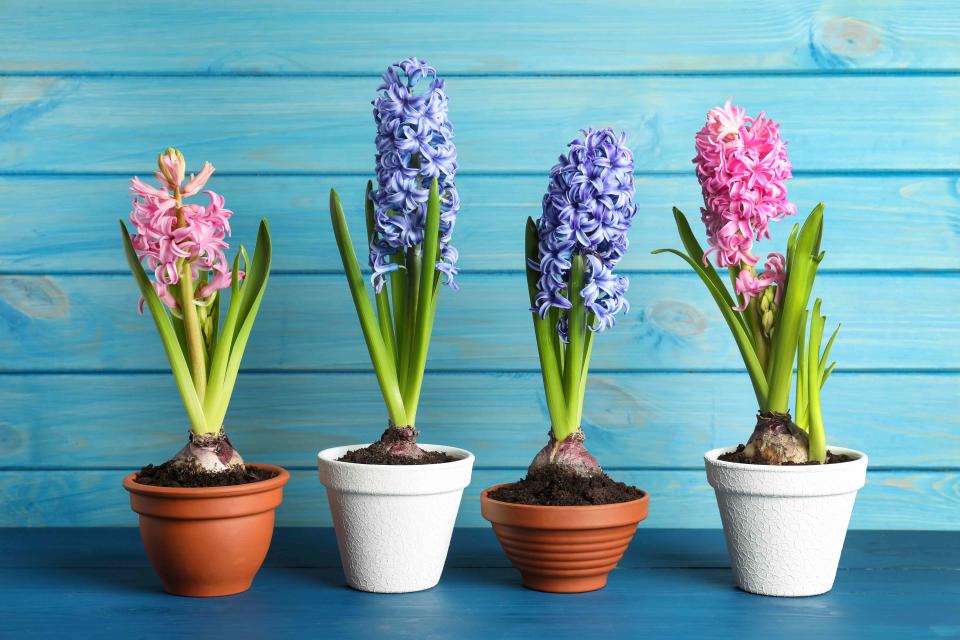How to Force Bulbs to Brighten Up Your Winter
It's easy to enjoy beautiful flowers all year long.

Liudmila Chernetska/Getty Images
Depending on where you live, it can get pretty cold and gray over the winter—which can make anyone beg for a little bit of color to enjoy. Enter the forced bulb. it's an easy way to trick your favorite bulb-grown flowers like paperwhites, daffodils, and amaryllis into thinking it's spring and blooming indoors during the winter.
And fortunately, learning how to force bulbs is a pretty easy task. You just need a little prep and a little patience to enjoy gorgeous blooms later this winter.
The Best Bulbs to Force Into Bloom
Forced bulbs are a popular addition to holiday decor, with dramatic amaryllis and pretty paperwhites the most common picks for forcing. But most spring-blooming bulbs can be forced to bloom in winter. Hyacinth and daffodils are usually considered the easiest to force, but tulips, snowdrops, crocus, and anemones can also be forced to bloom.
Related: 18 Christmas Flowers and Plants Perfect for Decorating and Gifting
How to Force Bulbs for Some Winter Color
You'll need to plan ahead to force bulbs, as most flowers require between two to four months of chilling before you can bring them out and let them grow and flourish, according to the New York Botanical Gardens. September to November is an ideal time to start your bulbs, depending on when you want them to bloom. Here's what you need to do to force the bulbs:
Related: 10 Plants That Bloom in Winter for Some Cheer During the Coldest Time of Year
1. Choose an appropriate pot
You'll want a pot that's large enough to give your bulb three to four inches for roots below the bulb, and that has drainage holes to allow excess water to drain. Otherwise, you risk rotting the bulb if it's allowed to sit in soil that's too moist.
2. Plant your bulbs
Fill the pots with damp potting soil. You can plant the bulbs close together, with their root side down. Small bulbs can be covered with a thin layer of dirt, but you can leave the tip of a larger bulb out of the dirt.
3. Give your bulbs a taste of winter
You need to keep your bulbs in a cold, dark environment that mimics winter weather. The temperature should be consistently below 50 degrees, but shouldn't dip below freezing. You could place your pots in an unheated garage, a cold frame, or even a refrigerator to create the right environment.
Keep your bulbs and your fruit apart.
Fruit that produces ethylene, like apples, can interfere with bulb growth, so keep your bulbs away from them.
If you need to store the forced bulb pots outdoors to keep them cold, cover them with an insulating layer like mulch, straw, or dry leaves to help protect them from a deep freeze or frost. (You may also want to put a metal screen over it, if squirrels and other animals might be tempted to steal your bulbs.)
4. Warm your forced bulbs up
Once you see a little growth on the bulb, it's time to mimic spring. Move them into a slightly warmer and more light-filled spot (even if that light is artificial). You'll want a spot that is consistently above 50 degrees, but below 65. This could be a garage, if the temperature is warm enough, or in your basement.
Keep your forced bulbs in this slightly warmer spot for a week, then you can bring it out to the main part of your home.
How to Care for Forced Bulbs
Forced bulbs will take a few additional weeks to reach full bloom after you've brought them into your home. You'll still want to continue giving your plant spring-like conditions, so keep your potted bulb away from intense heat like a radiator or heat register, which could impact its ability to bloom.
Keep your bulbs well watered, but not too wet to avoid rotting the bulb. You might need to stake larger blooms (especially large bloomers like amaryllis) to keep them upright so you can enjoy the full bloom.
Frequently Asked Questions
Can any bulbs be planted without soil?
Don't want a bulky pot of soil? A few bulbs do well with just water. Amaryllis, hyacinth, and paperwhites are all good choices. The trick is to place the bulb about a half-inch above the water, so the roots can reach it, but the bulb isn't at risk of rotting.
You can use special bulb vases that have a cup at the top to hold the bulb, and a vase beneath for the water, or set the bulbs on gravel in a glass container and fill water to about a half-inch below the bulbs.
Can you replant the bulbs in your garden?
The short answer: yes. But don't expect new blooms for at least a year (or usually two). If you do plan to replant, keep the pot in a sunny window and water after the bloom fades.
Once the leaves start to die off, let the bulb go dormant by putting it back in a cool dry place, then plant the bulb in your garden in the fall.
Gardening experts say that bulbs planted without soil will likely not rebloom when planted in the ground, so they should be tossed or composted.
For more Real Simple news, make sure to sign up for our newsletter!
Read the original article on Real Simple.

